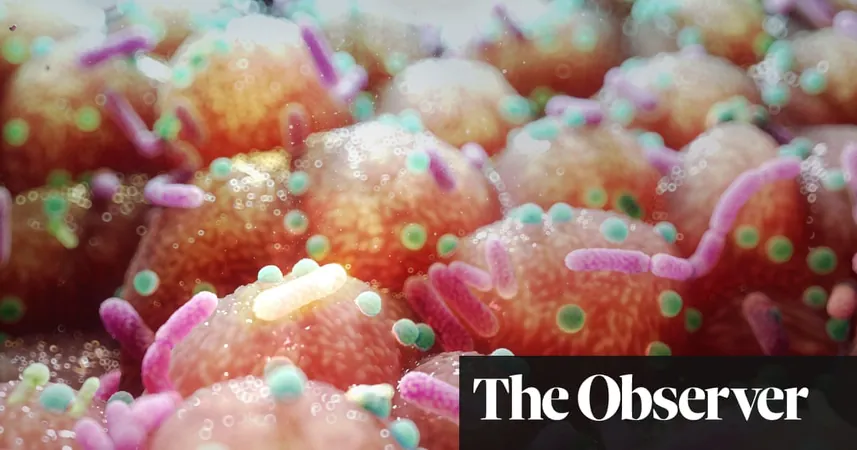
The Alarming Antibiotic Crisis: Could 40 Million Lives Be Lost to Superbugs by 2050?
2025-01-05
Author: Yan
Introduction
In a stark warning about the medical landscape ahead, Dame Sally Davies, a distinguished former chief medical officer for England, has sounded the alarm on a burgeoning antibiotic emergency threatening lives globally. In a recent interview with the Observer, Davies emphasized the dire consequences of antimicrobial resistance (AMR), which poses life-threatening risks to men, women, and children alike, especially during routine medical procedures like surgeries and childbirth.
The Current Situation
Davies paints a grim picture: currently, about one million individuals die each year due to AMR, a figure projected to escalate over the next 25 years to an astonishing 40 million lives lost. “It is genuinely horrifying,” she stated. Particularly alarming is that elderly populations are disproportionately affected, with 80% increases in mortality rates for those over 70 since 1990.
Factors Contributing to AMR
Experts attribute this rise largely to an aging population with a growing prevalence of chronic diseases. Such conditions make individuals more susceptible to the dangers posed by AMR, intensifying the urgency for action against this silent killer.
Agricultural Impact
While efforts are being made to minimize antibiotic prescriptions and encourage adherence to treatment protocols, the misuse of antibiotics is not the only culprit behind the rising tide of resistance. With roughly 70% of antibiotics administered to livestock, the agricultural sector plays a crucial role in facilitating the spread of superbugs. This raises serious questions about our farming practices, as Davies points out, “We’re using antibiotics on livestock as a cheap alternative to proper health management, allowing harmful microbes to adapt and grow stronger.”
Environmental Concerns
The environmental factors complicating this issue further include inadequate waste management in hospitals and intensive farming practices causing resistant bacteria to seep into our water systems. “The lifecycle of these resistant strains is alarming,” Davies warned, noting that contaminated water can disperse these bacteria across vast distances through natural elements like wind and rain.
Biological Challenges
Davies also highlighted the biological realities that perpetuate AMR; bacteria can multiply rapidly—approximately every 20 minutes—and mutate readily, passing their resistant traits to other bacteria they encounter. This rapid adaptation poses an escalating threat to public health, necessitating a focused effort to conserve existing antibiotics while urgently innovating new ones.
Pharmaceutical Industry Hurdles
Yet, the pharmaceutical industry faces significant hurdles. The last new class of antibiotics was introduced in the late 1980s, and the current market dynamics do not support the development of new treatments. Pharmaceutical companies often prioritize drugs like those for hypertension or cancer, which require consistent daily use and thus promise greater profit margins, leaving antibiotics underfunded and undervalued.
A Hopeful Outlook
Despite these daunting challenges, Davies remains hopeful. She stresses that tackling AMR is achievable but requires immediate, concerted global efforts—a call echoed by the G7 nations, who have acknowledged the crisis yet faltered in implementing concrete actions.
Conclusion
As we move forward, the question remains: will the world wake up to this impending crisis before it's too late? The clock is ticking, and with an estimated 40 million lives at stake, this battle against superbugs must become our top priority.

 Brasil (PT)
Brasil (PT)
 Canada (EN)
Canada (EN)
 Chile (ES)
Chile (ES)
 Česko (CS)
Česko (CS)
 대한민국 (KO)
대한민국 (KO)
 España (ES)
España (ES)
 France (FR)
France (FR)
 Hong Kong (EN)
Hong Kong (EN)
 Italia (IT)
Italia (IT)
 日本 (JA)
日本 (JA)
 Magyarország (HU)
Magyarország (HU)
 Norge (NO)
Norge (NO)
 Polska (PL)
Polska (PL)
 Schweiz (DE)
Schweiz (DE)
 Singapore (EN)
Singapore (EN)
 Sverige (SV)
Sverige (SV)
 Suomi (FI)
Suomi (FI)
 Türkiye (TR)
Türkiye (TR)
 الإمارات العربية المتحدة (AR)
الإمارات العربية المتحدة (AR)